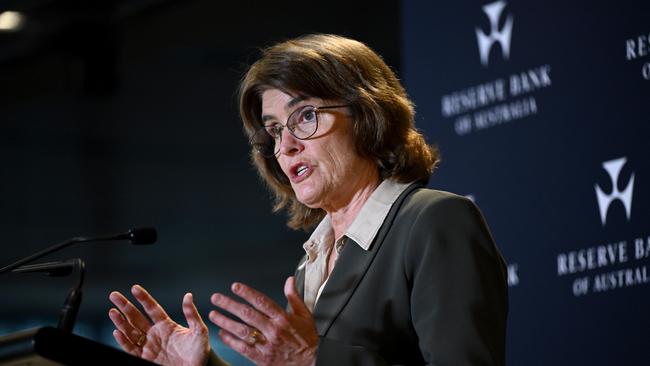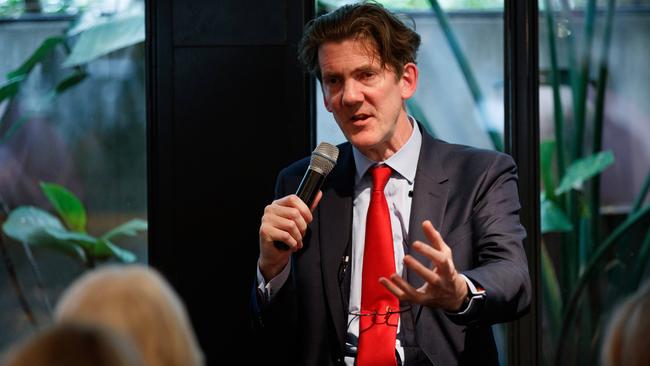Inflation is still the priority for the RBA but interest rate cuts are coming
The Reserve Bank has opened the door to potential interest rate cuts by the year’s end if the economy worsens yet has warned of upside risks to inflation that could trigger rate rises.

The Reserve Bank has further opened the door to potential interest rate cuts by the year’s end if the economy worsens while again warning of upside risks to inflation and a potential need to increase rates if overall financial conditions turn out to be insufficiently restrictive to return inflation to target.
In an overall hawkish assessment, the minutes of the September board meeting reiterated that lowering inflation to the RBA’s 2-3 per cent target remained the “highest priority” of the monetary policy board and that it “will do what is necessary to achieve that outcome.
Official interest rates would need to be “sufficiently restrictive until (RBA governor Michele Bullock and her fellow board) members were confident that inflation was moving sustainably towards the target range”.
But in a dovish twist, the minutes officially removed the board’s guidance from the August minutes that, “it was unlikely that the cash rate target would be reduced in the short term”.
“The September board minutes are a lot less hawkish than the August minutes,” said CBA head of Australian economics Gareth Aird.
“Expressed another way, the minutes today have made a dovish tilt to the RBA’s communication strategy on the outlook for monetary policy.”
Furthermore, the board “observed that there were scenarios in which future financial conditions might need to be less restrictive than they were at present,” the minutes said.
One such scenario was if the economy proved to be significantly weaker than expected and this placed more downward pressure on underlying inflation than expected.
The minutes said this could occur if households saved a significantly larger proportion of their incomes than expected, perhaps because of earlier declines in real income or more persistent uncertainty.
It could also occur if the jobs market weakened more sharply than forecast.
Another scenario was if inflation proved less persistent than assumed, even without weaker-than-expected activity. This could occur, for instance, if rent inflation fell more rapidly, falling petrol or other commodity prices materially reduced firms’ cost base or the decline in discretionary spending flowed through materially more quickly to services inflation, the minutes said.
“We view this change as significant,” Mr Aird said. “The board has now back pedalled from its forward guidance.”
Mr Aird said this shift was “prudent” as it was increasingly likely than not that underlying inflation for the September quarter would be below the RBA’s forecast and household consumption growth would not rebound in the quarter as strongly as implied in the RBA’s central scenario.
CBA expected the RBA to start cutting interest rates in December and lower its official cash rate target by a total of 1.25 percentage points to 3.1 per cent by end the of 2025.
To be sure, the dovish shift wasn’t strongly worded. The minutes spoke of a potential need for less restrictive financial conditions – which can be achieved by changes in financial markets rather than official interest rates – and these scenarios were “observed” rather than “discussed” by the board.

Speaking at the Business Journalism Awards on Tuesday, RBA deputy governor Andrew Hauser rejected the notion that the September board meeting minutes were “particularly dovish”.
“I don’t know whether I would describe … ‘we remain vigilant to upside risks to inflation’ as being a particularly dovish message,” Mr Hauser said in response to a question.
In keeping with the overall hawkish tone of the minutes, the board did discuss “scenarios in which future monetary policy might need to be held restrictive for a prolonged period or tightened further.”
One of these was if consumption growth were to pick up materially in response to the recovery in real household disposable income that was” likely to have begun around mid-year.”
If that were to occur, labour market outcomes could be stronger than forecast and inflation would return to target more slowly, the minutes said.
Another was if the outlook for aggregate supply proved to be more constrained than currently expected – for instance, if the economy’s current supply potential had been over-estimated or if future productivity growth turned out to be weaker than assumed.
Members also considered a formal analysis in which the economy’s supply capacity was more limited than currently assumed.
In this case, the cash rate “might need to be noticeably higher than the market path underpinning the August forecasts, in order to bring inflation sustainably back to target by 2026”.

The board “observed that monetary policy could need to be tightened, even if the board’s judgments about consumption, the labour market and supply potential prove correct, should present financial conditions turn out to be insufficiently restrictive to return inflation to target”.
“Members noted that the easing in financial conditions over prior months and the pick-up in credit growth made this scenario somewhat more plausible, as did the observation that banks were well placed to facilitate any strengthening in credit demand,” the minutes said.
Interestingly, members noted that each of these outcomes was “conceivable” given the considerable uncertainty about the economic outlook. And future financial conditions “might need to be either tighter or looser than at present to achieve the board’s objectives”.
“Members agreed that, while it was important to take account of economic developments abroad, it was not necessary for the cash rate target to evolve in line with policy rates in other economies since Australian inflation was higher, the labour market stronger and monetary policy less restrictive than in many other advanced economies,” the minutes said.
“The exchange rate could also adjust as interest rate differentials between Australia and other economies evolved.”
ANZ Bank’s head of Australian economics, Adam Boyton, said the minutes showed a “clear step down in the board’s hawkishness” which “leaves the door open to a shift to neutral by the end of this year and then easing by February 2025”.
Capital Economics said the minutes confirmed the board “softened its tightening bias”, though the forecaster still thinks the bank will wait until early 2025 to cut rates.
“Not only did the board not discuss the case for a hike for the first time since March, but it also sounded more concerned about downside risks to the economy,” said Capital Economics economist Abhijit Surya.
“In particular, members discussed the outlook for household consumption in great detail, given the unexpected contraction in the June quarter.”
“The board’s baseline case continues to be that household consumption will pick up in the second half of the year, in response to a recovery in real incomes.
“However, that prediction looks increasingly tenuous.”
It came as NAB became the latest major lender to cut fixed home loan rates for owner-occupiers and property investors, after reducing mortgage rates by up to 0.65 percentage points.




To join the conversation, please log in. Don't have an account? Register
Join the conversation, you are commenting as Logout